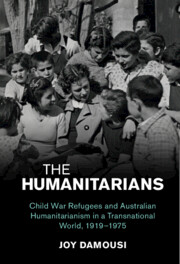 The Humanitarians
The Humanitarians from Part II - Evacuating
Published online by Cambridge University Press: 28 July 2022
The evacuation of 25,000 children from Northern Greece at the height of the Greek Civil War has a direct connection to Australia through the efforts of humanitarian Aileen Fitzpatrick, as discussed in Chapter 6. Drawing on arguments about notions of the family and the need for its continuation, Fitzpatrick was able to reunite children in neighbouring communist countries with their parents who had migrated to Australia. Several themes of significance run through Fitzpatrick’s efforts. Her argument for the unification of families echoed and endorsed the political and cultural discourse of the day, that the conventional family unit – the cornerstone of 1950s Australia – defined assimilation of migrants and upheld the ‘Australian way of life’. She hoped that in promoting an ideal of the white nuclear family, her appeal drawing together an emotional community would extend cross-culturally and would be supported in Eastern Bloc countries to allow children to be repatriated with their families. Saving the conventional family meant restoring the democratic way of life that she believed was defined by a 1950s understanding of the family. A focus on Fitzpatrick’s activities allows for women’s role as key players in international diplomacy and global movements to be highlighted, in ways that have not been recognised in accounts that focus on policy, the state and the role of diplomats.
To save this book to your Kindle, first ensure [email protected] is added to your Approved Personal Document E-mail List under your Personal Document Settings on the Manage Your Content and Devices page of your Amazon account. Then enter the ‘name’ part of your Kindle email address below. Find out more about saving to your Kindle.
Note you can select to save to either the @free.kindle.com or @kindle.com variations. ‘@free.kindle.com’ emails are free but can only be saved to your device when it is connected to wi-fi. ‘@kindle.com’ emails can be delivered even when you are not connected to wi-fi, but note that service fees apply.
Find out more about the Kindle Personal Document Service.
To save content items to your account, please confirm that you agree to abide by our usage policies. If this is the first time you use this feature, you will be asked to authorise Cambridge Core to connect with your account. Find out more about saving content to Dropbox.
To save content items to your account, please confirm that you agree to abide by our usage policies. If this is the first time you use this feature, you will be asked to authorise Cambridge Core to connect with your account. Find out more about saving content to Google Drive.